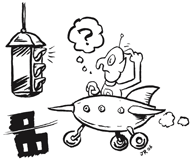Ask an expert: The artifice of colour and nature
Ask an expert: The artifice of colour and nature McGill University
User Tools (skip):
Ask an expert
The artifice of colour and nature
"Why are stop lights red, caution lights yellow and go lights green.
Is there a reason for the colours?"
Margot Kyle
John Galaty, professor with the Department of Anthropology responds:

Is it ethnocentric that we might feel that the three colours used in traffic lights seem remarkably.... well, "natural"? Can psycho-physics and neuro-psychology add to our social understanding that red means stop, yellow means slow, green means go?
Red to yellow to green covers much of the colour spectrum, but not all. The two extremes of the continuum of wave frequencies that define light cannot easily be seen by the human eye. Red has the lowest frequency discernible by the eye and is visible in very low light. So if you need a light to signal an emergency, or to make people "stop" or "watch out" in variable light, red is your choice. Red is also the colour of blood and the colour of fire, natural symbols of danger. For all those reasons, it catches the eye.
Green is red's complementary colour, its natural partner given the structure of the human eye. (Demonstrate this by a simple experiment — gaze at a red image, shift your eye to a blank, white wall; your eye will project the same image in green). The eye can discern more shades of green than any other colour, making it appropriate as a signal, especially when paired with red. In a verdant world, green is associated with life and growth, earth and nature. To go or not to go is not even a question in our green world where plants continually grow.
Yellow lies between red and green on the spectrum of wave frequencies. Yellow light stimulates both the red and green cone cells on the retina, but not the blue cones, so is the easiest of all colours to see at a distance. It is thus an appropriate signal for caution or a warning to slow down. A bright and cheerful colour, yellow is often associated with peace, contentment and happiness.
The traffic signals reflect both the nature of light and the structure of the human eye. The genius who invented the traffic signal must have drawn from both these natural qualities and socially-defined attributes in designing lights able best to communicate at a glance, for the impatient driver hurtling towards an intersection, the distinct commands of Stop, Go, and Caution.
Got a question? Email maeve.haldane@mcgill.ca

